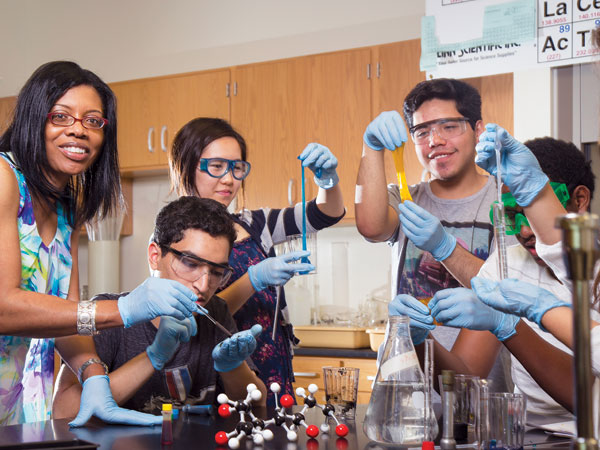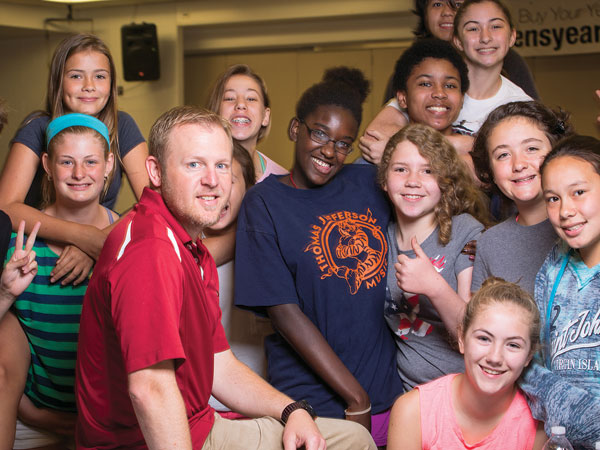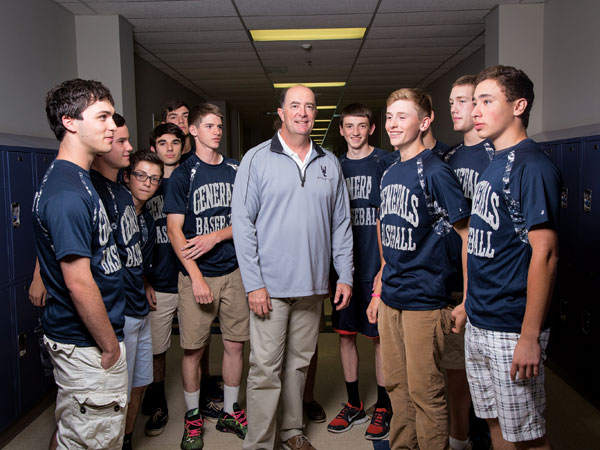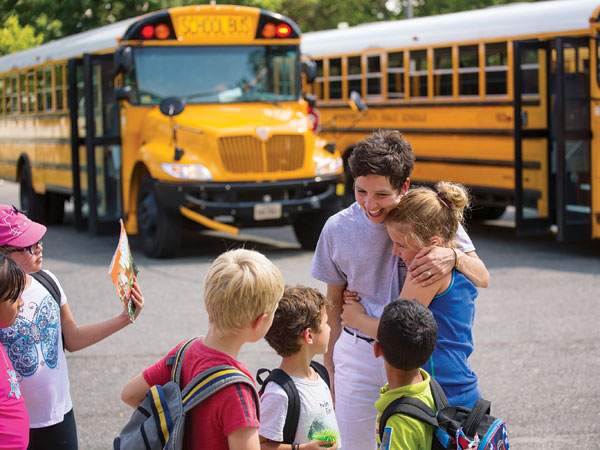Maria Sejas Cardenas
Second-grade teacher, McKinley Elementary School, Arlington
Years teaching: 12
Every child who walks into my classroom is unique, socially and academically. It’s my job to differentiate content for all my students. This happens through tiered instruction, flexible learning groups and ongoing assessments.
Second-graders are at the perfect age to learn self-reliance. They rise to the challenge of being responsible for their belongings and they begin to follow multi-step directions.
It’s important that students are put in situations where they have to work with others to learn how to collaborate and get along with everyone. I like to mix the kids up often so they are exposed to how others problem-solve, create or express their learning. It’s exciting to see them adapt and possibly do things differently. Working with others helps them build tolerance and patience.
Some days I have to stop teaching to save a spider, redo a ponytail, find the tooth that popped out of a mouth, fix a beeping wristwatch, get a Band-Aid for a hangnail or untie triple-knotted shoelaces.
I read aloud from a chapter book every day. I’ve recently read The One and Only Ivan, Because of Winn-Dixie, Pippi Longstocking, The Miraculous Journey of Edward Tulane and The World According to Humphrey. My all-time favorite children’s book is Charlotte’s Web.
Second-graders love learning, and they’re beginning to understand more sophisticated topics, like equal rights, making inferences and natural resources. They get engaged and excited about topics such as ancient civilizations and animal adaptations.
It’s hard to stick to the lesson plan when their discussions become meaningful and productive. So sometimes I don’t. Some of the greatest moments in my classroom have come from authentic, unplanned discussions and activities led by students. These are the moments that I love—watching my students question, reflect, infer, create or connect on their own. It means that I’ve done my job. —Kim O’Connell

Verlese Gaither
Chemistry teacher, Wakefield High School, Arlington
Years teaching: 17
Each year, I think: How am I going to teach students a subject that’s so abstract, in that it’s too fast to see and it’s too slow to see? It can be too large to see or too small to see.
I have to try to win them over. I’ve got to reach them before I can teach them. I always have a hook. It may be a skit, a short video, a game. Something that captures their attention!
Technology can be a distraction, but teachers can also use technology to their advantage. If we’re doing a lab and they say “Ms. Gaither, can I record this?,” I say “sure.” They capture the reactions on their phones and devices with video. But I also remind them that we’re working with chemicals, so they must exercise caution. If acid drops on a device, it’s going to ruin it.
One of my students’ favorite labs is the Flame Test lab. We burn wooden splints that have been soaked in salt solutions and we get the colors of the rainbow. They ooh and aah. They like anything that has to do with fire. They come in the door and say, “Are we going to burn anything today?”
Teaching is a symbiotic partnership. I think the teacher learns from the students and the students learn from the teacher. The most important thing I’ve learned is that I have to be flexible. Students are individuals just like we are. They have a range of emotions just like we do.
Relevancy motivates kids. In teaching chemistry you have to explain that chemistry is a part of everyday life. When we wake up in the morning and brush our teeth, take a shower or put on deodorant, we are using chemicals.
We can use materials in nature to manufacture chemicals. This year, my AP Chemistry class worked on a project to make methane gas using cow dung. The idea was to build a prototype that could be used by residents of a village in Botswana to produce biofuel. When cow dung is fermented in an airtight environment, it produces methane gas, along with hydrogen sulfide and carbon dioxide gases, after about two weeks. [To learn more, visit http://bit.ly/1JUJkTE.]
I always start each school year thinking that this year is going to be the best year ever. And it always turns out to be true. But of course the next year will also be the best year ever. And the year after that. —Madelyn Rosenberg

Barbara Ruff
U.S. history teacher, McLean High School
Years teaching: 27
Teenagers are just like little kids with big feet. They need the same things, the same attention and affection and respect that all kids do.
Kids are on their technology all of the time. I always tell them that if I see blue light glowing from their laps, I pretty much know what they’re doing. If my two children got a text from me, they would both faint dead away.
[Junior year] is a big year. They’re starting to realize that what they do is important. They have to start thinking about life after high school and what comes next. College? A gap year? Employment? The military?
Teaching has changed. Parents have changed—there’s more helicoptering around. Kids are basically the same.
We start pre-Columbus and we’re supposed to get to the present day by the end of the school year. I almost never get there. To me, driving to the end isn’t important. What matters is the skills that students learn while we’re getting there: reading, writing, comparing, analyzing. Understanding history is essential to understanding today.
I want them to know the difference between the Declaration of Independence and the Constitution. I want them to know what rights are guaranteed to them in the Bill of Rights. And I want them to think about why that happened and how it happened, and how that group of people came to be assembled in one room at one time in our history.
The kids love World War II because it’s a war where we’re the good guys. The bad guys are really bad, and the good guys are really good.
I read the students’ names at graduation every year as they walk across the stage to get their diplomas. Reading the names right is so important. We have kids from all over the world and their names reflect that. I’ve learned how to roll an R.
I try to use humor as much as possible and laugh with them as much as possible. Every day I learn something from them—not necessarily history, but something.
I’m saddened by the fact that I’m close to retirement…because I’m getting good at this. I don’t mean I know more about history. I know more about kids. —Madelyn Rosenberg

Matt Sowers
Seventh-grade school counselor, Mary Ellen Henderson Middle School; former varsity boys’ tennis coach, George Mason High School, Falls Church
Years teaching: 15
The students I counsel today are experiencing high levels of stress, anxiety and depression. Often the independence that they are gaining in middle school can cause stress—whether it stems from changing into a P.E. uniform for the first time, memorizing multiple locker combinations, or being in charge of logging into a computer to follow their grades. I encourage parents to continue conversations with their children so that they are aware of their child’s challenges, both in and out of school.
Social media has made it more difficult for students to differentiate and find a healthy balance between personal connections with peers at school and clicking the “like” button on a Facebook or Instagram post. The rules of engagement are not the same.
Some kids come to school bearing heavy loads. In one of my first years as a counselor, I had a middle school student whose parents were in the midst of a divorce. I helped the student become involved in multiple extracurricular activities and receive additional mentoring to weather the transitions that were occurring on the home front.
I think it’s interesting to see how students act in different settings. A student who is extremely quiet, shy and withdrawn in the classroom can become overly animated behind a closed door in the counseling office.
As a tennis coach, I learned the importance of focusing on the mental aspect of the game just as much as on the conditioning, drills and technique. I got the most out of my players when I would build their self-esteem and confidence.
Don’t let wins and losses define your career. It’s the personal connections and the lasting impressions you make that matter.
I tell new and veteran educators not to take anything personally in middle school—whether it’s interactions with parents, staff or students. There are times we all may disagree on the delivery of instruction or how to support a student, but at the end of the day we are all here to support these kids.
Hit the reset button at the end of each day and learn from your mistakes. Doing so will make you a better teacher, coach, spouse and parent. —Kim O’Connell

Kristin Niketic
Fourth-grade teacher, Discovery Elementary School, Arlington
Years teaching: 11
I think I was raised to be a teacher. I am the oldest of 13 cousins, and I spent much of my childhood taking care of kids. My mom is a teacher, too.
I believe in experiential learning. In the ideal scenario, we would use fractions to measure ingredients and cook. We would plant gardens, create art, go to museums, shadow professionals in their jobs and visit nursing homes. I do my best to create simulations in which students can apply the educational standards out in the world.
Public schools would be better if everyone accepted the fact that a test score isn’t everything. As teachers, we are often told that standardized test scores aren’t high enough and therefore, what we are doing “isn’t working.” When you see small victories in the classroom every day, you know this isn’t true.
Kids learn best when they feel good. If you like your classroom, your teacher is nice, there’s no criticism for asking questions, and you’re working toward a real goal, learning happens.
One of my students recently taught me how to make a pencil case out of duct tape. So cool!
I’ve learned never to underestimate kids. I had one student who cried and repeatedly asked to go to the nurse, claiming a stomachache, because she was terrified of giving a speech. Months later, we were organizing a school poetry reading and the same girl who had once shaken at the thought of standing in front of the class applied to be the master of ceremonies. She wanted to overcome her fear. She got the job and she was amazing. To top it all off, she finished off the year by giving the fifth-grade promotion speech.
Once, while reading a story to the class, I noticed that one of my students was sitting apart from the rest of the group. I stopped and asked if he was okay. He said he was distracted because there was a bug inside his ear. Indeed, there was.
Parents are a child’s first teachers. When a parent reads, kids follow that model and read. When a parent speaks with a varied vocabulary, kids do too. When parents have positive attitudes about school, kids do too. As teachers, we do everything we can to positively impact kids, but we are only with a child for one step in the journey.
The best assignments allow kids to find their strengths and the passions that lie within them. Children should never be boxed, and quite frankly neither should teachers. —Jenny Sullivan

Doug Grove
Psychology teacher and varsity baseball coach, Washington-Lee High School, Arlington
Years teaching: 27
I’m a native Arlingtonian and Washington-Lee graduate. After going to college at James Madison University, I started coaching baseball and teaching at W-L. It was great, because my favorite teachers from high school were all still here—including Tim Wyatt, who taught American Civilization. Being able to start my career with him as my mentor was such a gift. Everything I’ve been able to do I owe to him.
In the IB classes, we’re delving into cognitive and social neuroscience. We study new research that may have been conducted as recently as last fall—studies out of Stanford or Princeton. Students do a variety of experiments, mostly related to memory. They especially like projects that study how music triggers memories. The AP class is more of a survey, hitting all the major aspects of psychology.
My teaching strategy is one of “relaxed attention.” They’re going to laugh, but they’re going to learn too.
Here in Arlington, we’ve become very aware of the stress students are under—both self-directed and from parents—so I strive to balance the demands of the curriculum with each student’s particular workload and personality. The stress they’re feeling is very real. The students appreciate it when they know you’re working with them. On the other hand, they also need to be challenged.
Spontaneity is very important. In all the classes I’ve taught in 27 years, there has never been an identical class.
The key to both teaching and coaching is preparation—getting these kids prepared to do their best. There’s nothing better than seeing a student or athlete “get it” and witness that moment when they believe in themselves.
—Kim O’Connell

Lynne Wright
Principal, Oakridge Elementary School, Arlington
Years teaching: 18
I love the first day of school: all of the possibilities, the hope, the positive energy. I love the newness of it all—even new sneakers.
Everyone is important; every single child, parent and staff member. I’ve always loved working with people and helping them to find their strengths.
I encourage parents to be present. Not just physically present, but emotionally present when their children are with them. And to read with their kids every day, as often as possible.
We have 70 different birth countries and 45 home languages at our school. I’ve learned how to say hello and goodbye in many languages—Chinese, Japanese, Arabic, Kazakh. But my pronunciation is terrible.
About midsummer every year, just after summer school starts, we have dragonflies that hatch in the woods behind our school. We have thousands of dragonflies flying around our field. It’s just whimsical.
For the 100th day of school, many teachers have students bring in 100 of something so that students have a better understanding of what 100 looks like. A first-grader brought in 100 different types of currency. And someone brought 100 hangers once.
I walk the halls and visit classrooms as much as possible. In the process, I’ve gone from wearing 3-inch heels, to 1-and-a-half-inch heels, to flats, because I do so much walking. I have to replace my shoes twice a year.
I have an open-door policy…but it’s 90 percent by appointment, because I’m rarely in my office.
It’s all about relationships and trust. I’m so glad that families trust their children in our care.
“You’re a good egg.” I say that a lot. And “thank-you.”
